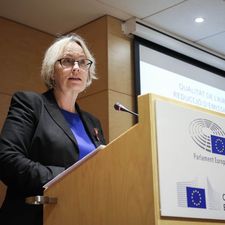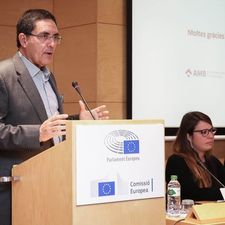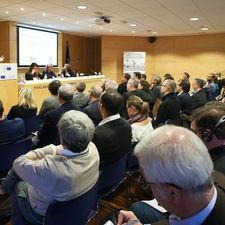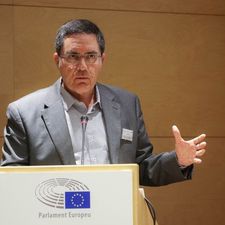United against air pollution in Europe
| Subject: Sustainable Mobility, International Relations
The administrations are committed to sustainable mobility and to reducing traffic in urban areas by 25%
The AMB took part in the conference on air pollution called ‘Air quality: reducing polluting emissions in Europe' which was organised for today by the Barcelona Office of the European Parliament. The conference included a debate with EU members of parliament, public authorities, scientists and social agents on the legislative package on air quality that is currently being worked on in the European Parliament. In addition to contributing their vision of the problems involved, participants debated on the measures that must be taken in order to reduce emissions.
Participants from the Catalan public administrations included representatives from the AMB, the Generalitat de Catalunya and Barcelona City Council, which made the coordination between these three institutions clear as an essential and key point for reducing the nearly 50% pollution caused by combustion vehicles.
The solutions presented by the administrations include reducing traffic by 25%, a commitment to more sustainable mobility and increasing public transport.
The AMB was represented by the director of Mobility and Transport, Joan Maria Bigas, the Generalitat by the managing director of Environmental Quality and Climate Change, Mercè Rius, and the Barcelona City Council by deputy mayor, Janet Sanz.
Diagnosis and solutions for the pollution problem in Europe
With regard to other participants in the debate, the presence of European Parliament member Julie Girling merits mention, a member also of the Commission of Environment, Public Health and Food Safety and the Commission to Research Emission Measurements in the Automobile Sector. Girling is working on the European directive to reduce national emissions in specific air pollutants, which is planned for approval at the end of November and sets targets for 2020 and 2030.
‘What we are working on now is not a perfect agreement, but it does represent a commitment by member states so that they can apply the necessary measures. Change must be made to improve this issue,' explained Girling. ‘The public debate on air pollution has changed. Without need to go further, last week schools in New Delhi had to close their doors because air pollution represented a real danger to the children,' she added.
Part of the solution to the problem is moving toward much more sustainable mobility and reducing traffic in urban areas by 25-30%. Among the measures pointed out by Joan Maria Bigas, director of Mobility at AMB, are the implementation of low emission zones, the creation of park-and-ride car parks next to railway stations, the regulation of urban goods distribution, the creation of a large metropolitan bicycle lane network and the conversion of public roadways into pedestrian walkways. ‘On public transport, we are working to modernise public fleets with hybrid, electric and natural gas vehicles, to create HOV-bus lanes, such as the C-245 and the B-23, and on traffic signal priority,' explained Bigas.
Beyond these structural measures, the administrations also evaluated one-off and extraordinary measures for handling possible air pollution episodes. These episodes ‘let us give them more visibility, raise the population's awareness and try out specific measures,' stated Mercè Rius. Toughening the criteria for low emission areas, limiting taxi traffic, increasing the price of regulated parking and temporarily converting roadways into pedestrian walkways are some of the measures pointed out by the AMB's director of Mobility.
Image gallery
Related documents
Where


















































